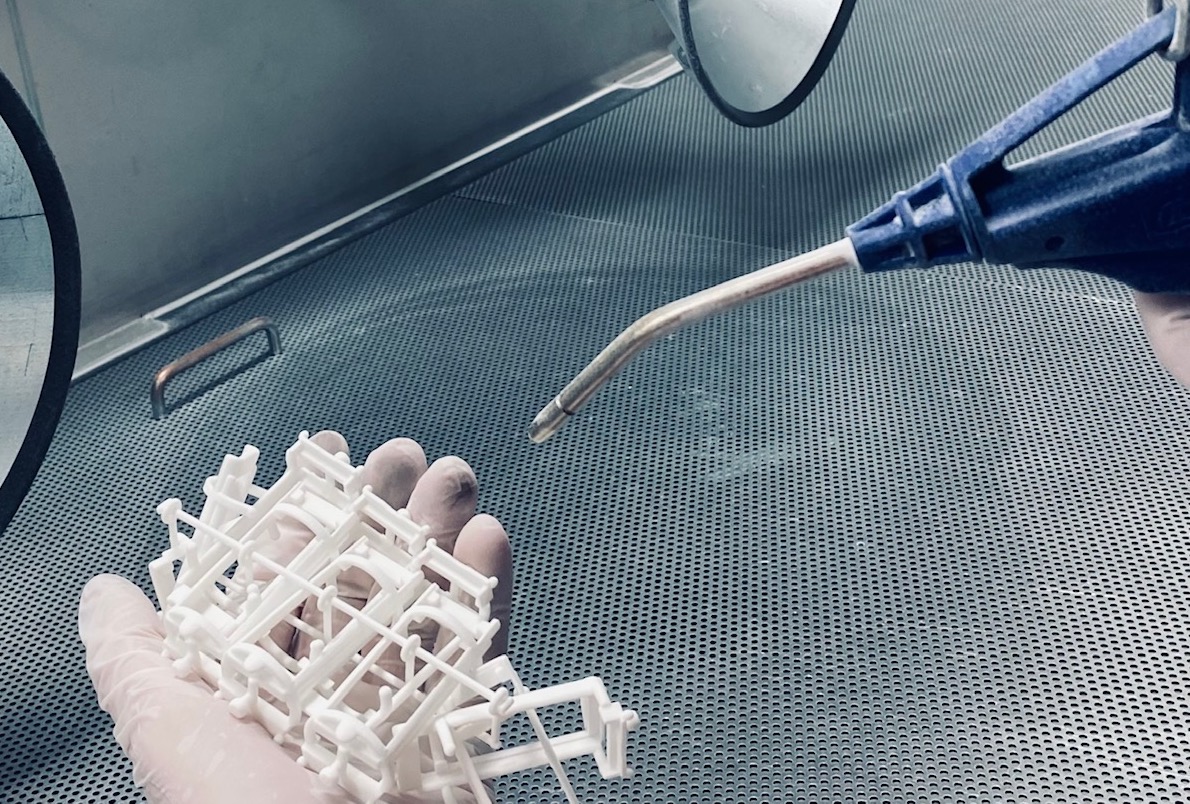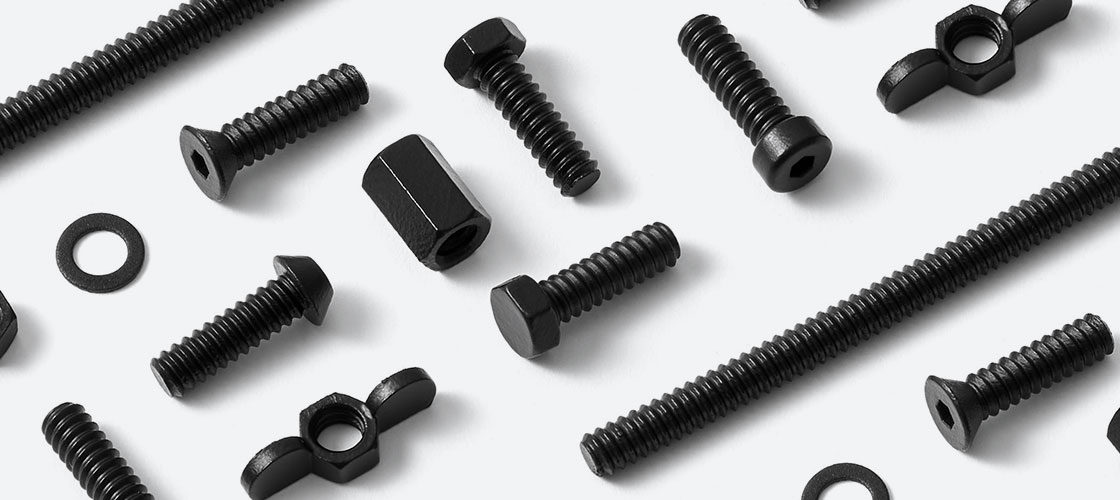Whether 3D printing an innovative medical device that is going to have a huge impact on the quality of life for patients worldwide, or fabricating something more pragmatic like a spare car part previously thought to be obsolete, the journey at Shapeways begins with a 3D design or a model made from a 3D scan—along with the subsequent variety of choices in materials, technology, and settings. The business of 3D printing is very exciting from start to finish, ending with all the options available in post-processing.
While some post-processing is centered around the routine and the required, from removing supports to cleaning, there are many different avenues to take in finishing—and the steps taken once 3D printing is completed can make the significant difference between a rough part or a highly-finished product. Almost all 3D printed parts require at least a minimum of post-processing and finishing, necessary to improve the integrity of a part—as well as enhancing the appearance. This can be a highly satisfying part of the journey too, watching a newly printed part transform into a polished product.
The goal is to complete all post-processing steps without compromising or damaging parts, especially when separating intricate supports or wearing away material during extensive finishing.
“At Shapeways, post-processing is an integral part of our entire production process for every material,” says Zach Dillon, User Application Team Lead at Shapeways. “Some parts come out of the printers with supports or rough powder still left on the model, but the series of steps involved in post-processing takes each model from that ‘fresh out of the printer’ state to a consumer-ready part.”
Dealing with Supports
Designing and removing 3D printing supports does involve some additional work and the use of additional material; however, without such efforts, issues could arise in products later. The use of supports also allows Shapeways customers the freedom to 3D print much more complex structures.
When comparing additive manufacturing (AM) technologies in terms of post-processing, it is easier to begin by pointing out those that do not rely on support structures for stability of parts; for instance, with custom 3D printing methods like Selective Laser Sintering (SLS), often used with popular materials like Nylon 12 [Versatile Plastic], or Binder Jetting with Stainless Steel 316L or Steel, there is so much unused powder surrounding parts during the printing process that they are naturally bolstered and supported by the extra material. That saves an extensive amount of time in post-production, but excess material does need to be removed, and recycled, whether through brushing or blasting.
For Stereolithography or Material Jetting, building in support structures is one of the necessary elements required for 3D designs not only to handle overhangs and prevent collapse of parts, but also to provide support and stability from the print bed, and dissipate stress on parts from high temperatures. Supports also make it easier to 3D print more complicated or sophisticated geometries. While there is always the option of using deliberate strategy to decrease the amount of support structures, they must be removed carefully—whether they are soluble or insoluble.
This is often an easy process, but again, one that entails careful maneuvering around a part to remove the supports. Meticulous work is key to all post processing; after all, what a shame it would be to have completed the design process, met success in 3D printing—only to ruin it all at the very end, and even more ironically, in removal of a structure meant to protect the integrity of a part or prototype. Residual marks are sometimes left but they can be quickly resolved with sanding—a process typically also relied on for refining surface finish.
Cleaning
Cleaning is the most important task in post-processing, setting up the foundation for everything that comes afterward, from finishing to dyeing. This procedure varies though, in terms of technologies and materials.
“All parts are cleaned,” says Dillon. “Then there is additional finishing that usually follows, depending on what was ordered, to include further polishing to get a smooth finish or dyeing to get some different colors.”

Cleaning required for Nylon 12 [Versatile Plastic] serves as a great example, as it is required for the actual process of removing additional material left on the part after SLS 3D printing. And while it does mean dealing with excess powder, the process is simple enough. Blowing away extra powder is effective with the use of compressed air, but extra special care must be taken if parts are fragile—often using mild solvents instead. The goal is to create a smooth surface for further finishing, avoiding complications in steps like dyeing if extra powder is still clinging to the part.
For High Definition Full Color, used with Material Jetting, Shapeways removes supports and then rinses each part. Afterward, a matte coating can also be applied if requested by the customer.
Dyeing
Nylon 12 [Versatile Plastic] is an incredibly popular material, especially with the option to use color. Available in standard white, parts can be dyed in eight other colors too: black, pink, red, orange, yellow, green, blue, and purple. This process is also possible for MJF Plastic PA12 for printing in gray or black.
Benefits of dyeing include comprehensive coverage of color as parts are submerged in dye, with the desired hues completely seeping in, along with eliminating the possibility of chipping or flaking in comparison to the use of traditional paint in post-processing. While dyed products may be vulnerable to discoloration due to handling, they can be coated with varnish for added protection.
Premium Finishes and Polishing
For Nylon 12, natural, processed, and premium finishes are available, ranging from a basic rougher texture to a smooth, scratch-resistant surface meant for high-end products, and featuring an eggshell sheen.
For obtaining the ultimate in clarity and the ability to request additional post-processing for creating smooth surfaces without layer lines, find out more about other materials like Accura Xtreme, made for production of 3D printed parts on any scale with high resolution.
Vapor Smoothing

Shapeways offers MJF Plastic PA12 in a natural matte finish. A smooth finish is also available, created with an automated vapor process to create a remarkably smooth surface with a shiny gloss. The physio-chemical process, basically melting the surface, smooths out any lines while still protecting the quality of the 3D prints in Black Smooth. Internal cavities can be smoothed also, resulting in a watertight part with all of its mass intact—in comparison to a polished part which does experience loss of material during the process.
Shapeways Considers Post Processing Before a Model Even Hits the Printer
At Shapeways, post-processing may occur at the end for a product, but planning for that process begins with proprietary software as soon as the 3D model is sent to the printer. Because one industrial 3D printer may be responsible for printing hundreds or even thousands of parts at a time, smart packing of parts is critical. This process, also known as nesting, involves putting together a puzzle of parts in the build tray, negotiating space for 3D models based on size, structure, and level of fragility.
Responsible for overseeing designs, materials, manufacturing, and managing quality overall, Shapeways Production takes each part from its beginnings as a 3D model to the end as a finished product. The User Application Team also specializes in analyzing 3D models for any printability issues, and may be able to fix files or alert customers to problems that need to be resolved before going forward.
Post-processing also offers the opportunity to keep the momentum going in production, whether accelerating product development through rapid prototyping, or continuing the production of functional, end-use parts.
“3D printing would not be where it is today without these crucial steps to improve the overall quality of parts,” says Dillon.
About Shapeways
Contact Shapeways now to enjoy the benefits of advanced technology and materials for manufacturing your creations with accuracy, complex detail, and no minimum or limits in terms of mass customization or single part orders. Shapeways has worked with over 1 million customers in 160 countries to make over 20 million parts! Read about case studies, find out more about Shapeways solutions, and get instant quotes here.


